12 Content Promotion Strategies To Strengthen Your Content Marketing
Topic: Content Marketing
Published:
Written by: Bernard Huang
Creating high-quality content is one of the top priorities for any business. Engaging, relevant content will pique your audience’s interest and boost conversions.
Let’s say you’ve created an Instagram reel on how your fitness products have helped people lose weight.
But is your work done after you’ve created that awesome reel? No, it also needs to reach your target audience effectively.
According to HubSpot’s 2022 marketing report, 25% of marketers find it challenging to reach their audience, and another 23% find it tough to gain and keep followers.
Content promotion helps content — like articles, podcasts, and videos — reach your target audience through emails, social networks, and search engines.
In this guide, we’ll discuss the top content promotion strategies to grab your audience’s attention.
Types of content promotion
Businesses use various channels for promoting their content. So, based on the channel type, you’ll use different types of content promotion.
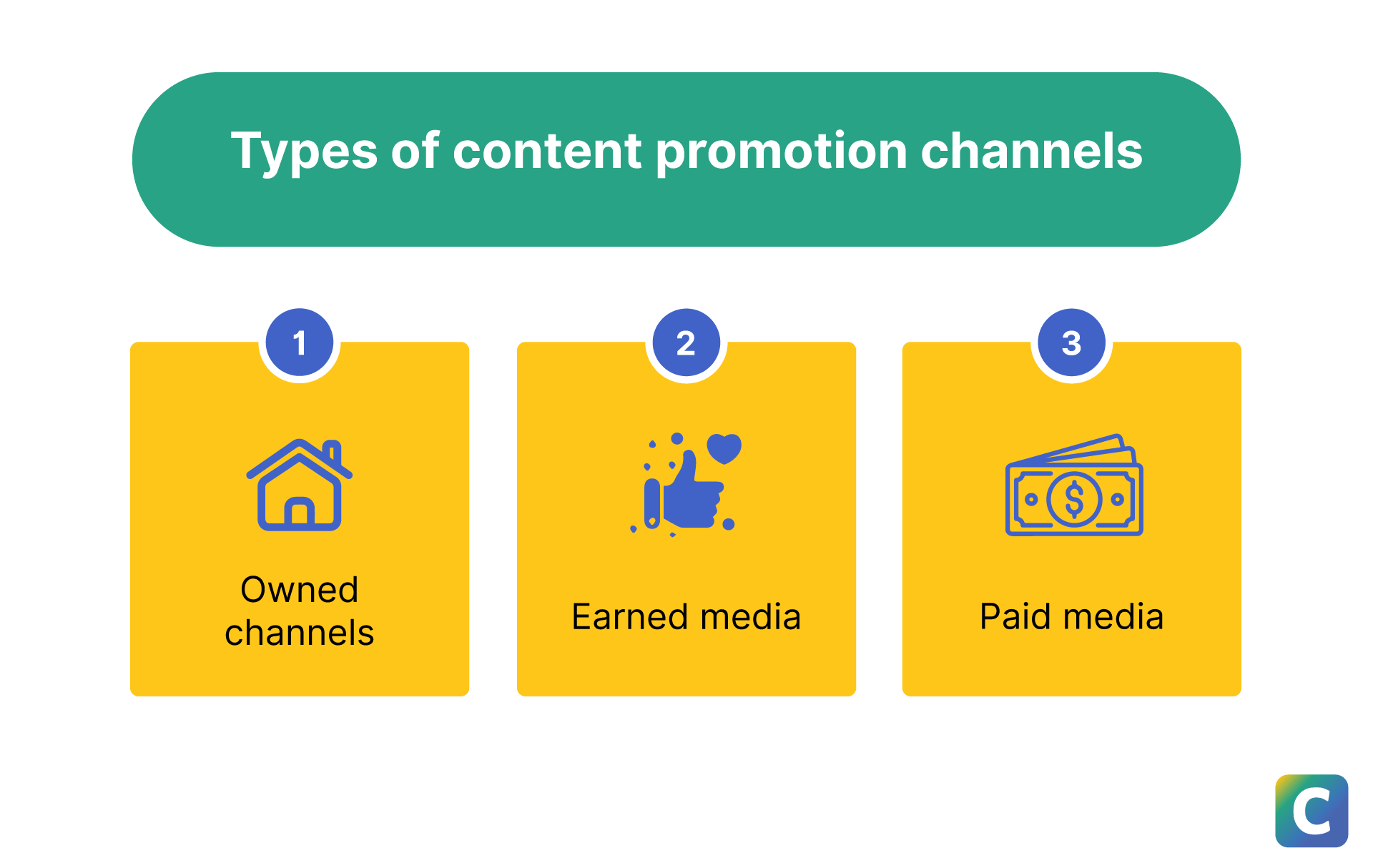
Types of content promotion channels: owned channels, earned media, paid media.
Promotion through owned channels
You may have an email list with thousands of subscribers or a social media handle with millions of followers. These are the content distribution channels you own — channels where you control the content.
Your email, website, and social media accounts are examples of owned channels.
Advantages of owned channels
You have complete control of your owned channels. They give you flexibility in content promotion. You’re able to:
Distribute your content without paying promotional fees
Send any number of messages at any time
Publish diverse formats and customized content
Easily monitor promotion campaign performance
Disadvantages of owned channels
Owned channels are great for promotion, but if you’re a business just starting out, you might not have many followers on your owned media. It takes time to attract genuine followers, so owned channels might not make a difference in your early content marketing strategy.
Also, note that just because you can send unlimited messages through owned media doesn’t mean you should. Be strategic with the volume and type of content you want to send out through these channels.
Promotion through earned media
Earned media
Media coverage in print, TV, radio, and live events are traditional earned media. Digital media coverage, social shares, reviews, social media mentions, and backlinks are digital forms of earned media. This guide focuses on digital earned media.
Here are a few ways to gain earned media promotion:
Establish yourself as a thought leader in your niche
Offer value to people through your unique, quality content
Nurture relationships with customers, media, and influencers
Continually engage with customers and other stakeholders online
Search rankings are an example of how content on your owned channels, like blogs, can also gain an audience through earned media. So, the promotion you get through SERPs is a mix of earned and owned media promotion.
Earned content syndication and guest posts on channels other parties own are two more examples of earned media promotion.
Advantages of earned media
Earned media empowers you to reach a much wider audience than owned channels. It’s generally more credible to people as you aren’t talking yourself up. It also helps you cultivate your image as a trustworthy brand and thought leader.
Earned media promotion happens in part out of goodwill, and you don’t need to spend money on it. But it also has a flip side — you can’t “buy” earned promotions. You must network and collaborate with people and brands in your domain.
Disadvantages of earned media
In earned media, you don’t have much control over your brand image. For example, if a news story focuses on a negative aspect of your brand, you’re unlikely to be able to retract the article.
Earned media promotion also doesn’t work quickly. You need to gain the trust of third parties so they’ll publish your content. But you might not have access to the performance data or analytics tools these third parties use. So, it can be difficult to monitor and measure the success of these promotions.
Promotion through paid media
Paying for other channels to promote your own content is considered a popular tactic in a well-rounded marketing strategy.
According to HubSpot’s marketing report, 80% of marketers use some kind of paid media, like:
Social media ads
Google pay-per-click (PPC) ads
Promotion through community websites and paid content networks
Non-internet placements such as sponsored golf tournaments and sports team sponsorships
Advantages of paid media
Paid promotion helps draw your competitors’ audience to your content. For example, Google’s PPC ads will show your content on SERPs where your competition is likely to rank.
Paid promotion has other benefits:
It’s straightforward to track your results and adjust your promotion tactics
It helps you reach your audience in an effective and timely manner
You can target your ideal audience
Disadvantages of paid media
Unlike owned and earned channels, paid media promotion can be costly in a highly competitive market. According to WordStream, the average cost per click (CPC) for a paid search placement is between two and four dollars, but the average conversion rate across industries is just 6.72%.
Other downsides include:
Chance of your ad being placed near a competitor on SERPs
Having to outbid competitors to get your ad placed on SERPs
Too many ads, especially on social media, might put off prospects
Prospective customers might find paid ads disruptive and annoying, which could result in a negative brand association
Why is content promotion important?
Creating great content is only useful if it reaches the right audience. According to Statista, global data creation and consumption grew from 41 zettabytes in 2019 to a projected 120 zettabytes in 2023.
In this era of content explosion, your audience is already overwhelmed with information. Without strategic promotion, your content might not get the traction it deserves.
Creating content without considering a complementary content promotion plan is often a waste of time. So, content promotion is a must to ensure a return on investment (ROI) for your efforts.
Content promotion done well can:
Convert prospects into customers
Drive traffic to your website
Create brand awareness
Reach new audiences
Choose the right audience
The most crucial aspect of content promotion is to promote it to the right target audience.
Your content promotion efforts must focus on the audience interested in your products. For example, if your brand operates in education, you might target students, teachers, and others in academia.
Difference between promotion & advertising
Advertising mainly focuses on selling your products or services to potential customers. Promotion is a broader approach to making your brand familiar to your target audience.
Along with spreading brand awareness, promotion also attracts your target audience by sharing niche-specific knowledge and engaging them online and offline.
A TV ad for your product is an example of advertising. In contrast, a long-form article addressing customer pain points, a meme recognizing a customer dilemma, or a paid social media influencer post are examples of content promotion.
Unlike advertising, not all promotional material aims to sell a product. Brands use promotion for different goals, such as:
Building authority in their domain
Engaging and informing their target audience
Creating brand awareness and affinity with their target audience
Both advertising and promotion can result in sales, but one is direct, and the other is indirect.
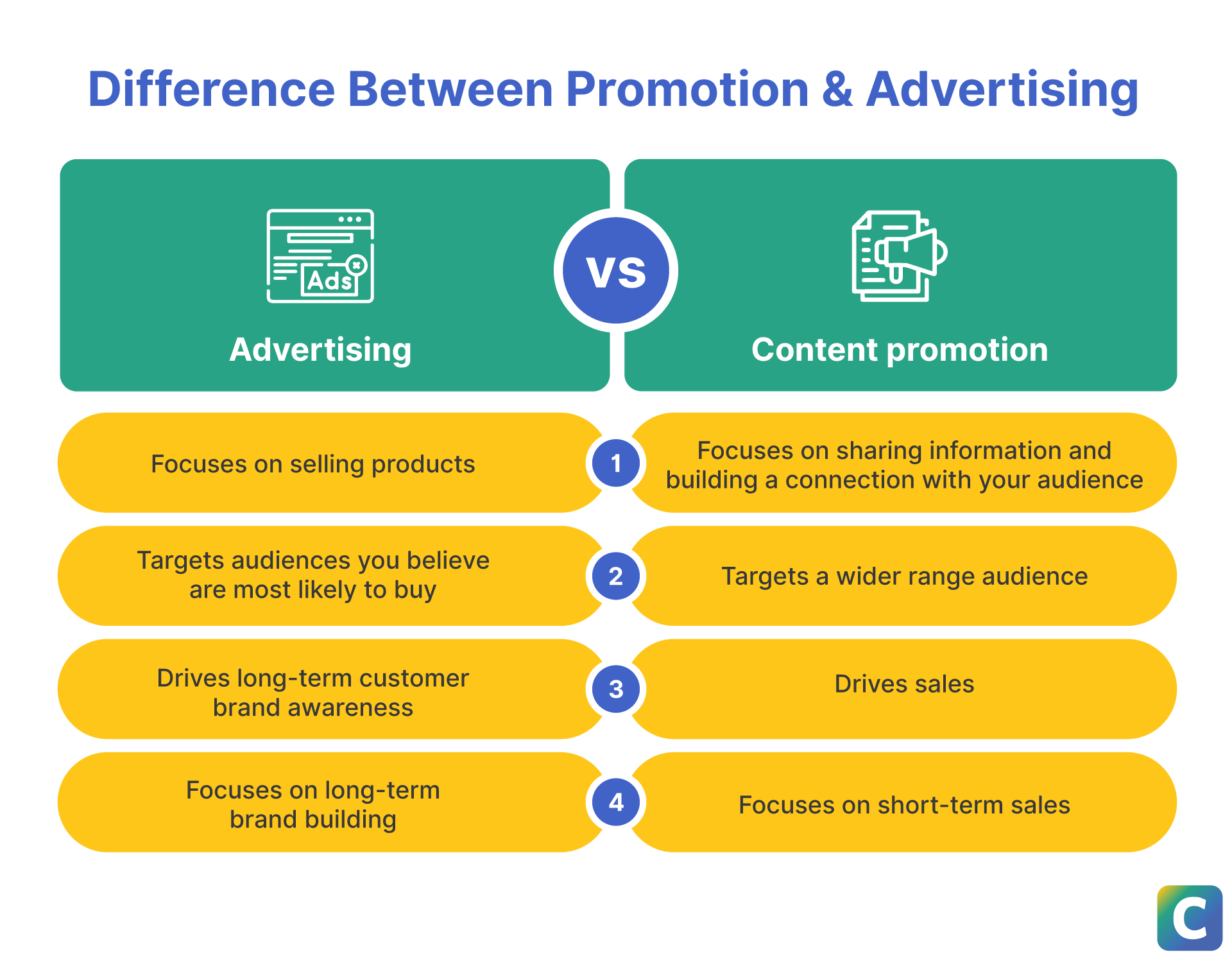
Difference between advertising and promotion.
Content promotion strategies
Include content promotion in content creation planning
Optimize your content for search engines
Repurpose your content for promotion
Use social media to promote your content
Promote content through your email lists
Collaborate with influencers
Tap your collaborators’ micro-networks
Make your content easy to share
Explore paid ads
Use content syndication and communities
Use converged media
Monitor content promotion performance
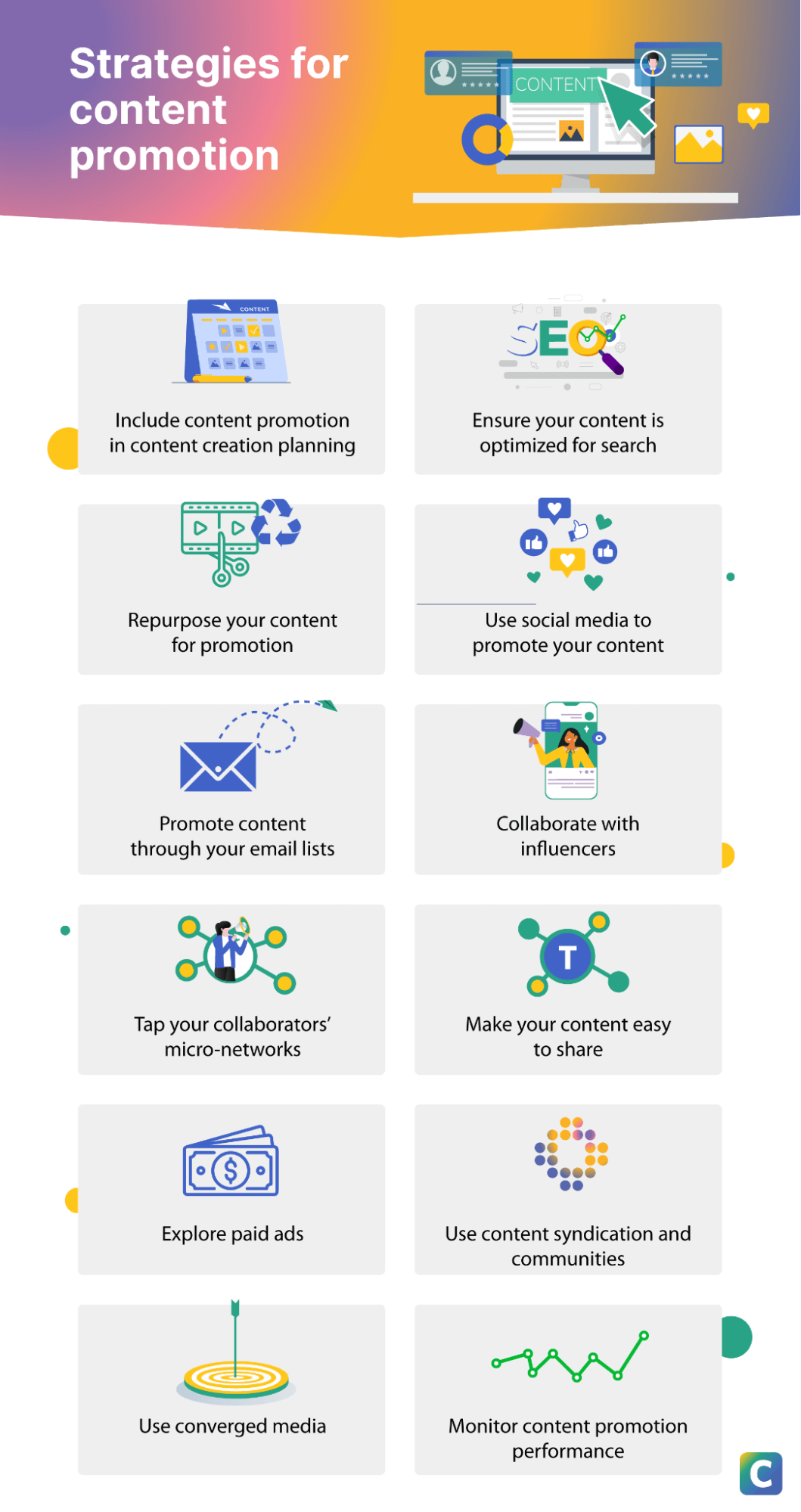
Content promotion strategies.
Include content promotion in content creation planning
When you start creating content, keep content promotion in mind. Start with the end in terms of how you’re going to repurpose content for promotion.
For example, you can convert an article into a slideshow or social media carousel. And you can convert an opinion piece into a series of quotes for social media.
First, determine the channels you’ll use to promote your content. Let’s say you want to promote it on Instagram. You can work with a designer to create stand-out images for the platform.
You may also opt to create ready templates for your social media content promotion. Doing this reduces the effort required to start promoting your content as soon as you publish it.
While creating content, make it easy to pull promotion-ready material from your article:
Highlight exciting stats in the content and create complementary graphics
Create shareable social media images around mic-drop quotes
Highlight or leave comments on all promo-worthy quotes
Camille Trent, Director of Content & Community at PeerSignal.org, believes it’s crucial to consider distribution during the content creation process.

Camille Trent, Director of Content & Community at PeerSignal.org, on content promotion.
If you want to repurpose your content easily, don’t bury the lede — let the content’s title or introduction convey the most crucial idea. Then, when you post content on social media, you just need to pull the title or the first sentence.
Camille refers to this concept as bottom line up front (BLUF).
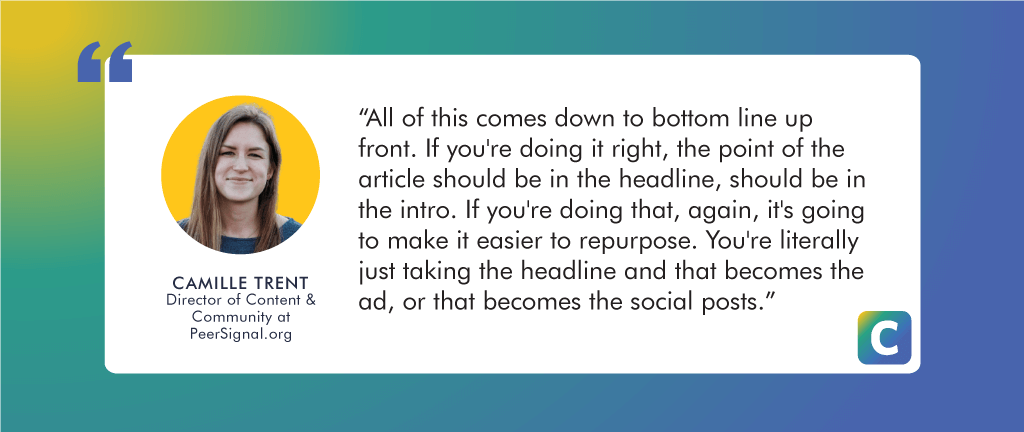
Camille Trent on content promotion.
Optimize your content for search engines
Optimizing your content for search engines is a great content promotion tactic. It helps you reach more people by increasing the chances of ranking high on relevant SERPs.
Search engine optimization (SEO) is one of the best content strategies to appeal to earned channels like SERPs and social media. With the right approach to SEO, you’re crafting content relevant to your audience, which should lead to action such as clicking through or sharing it.
SEO also helps you make the article relevant to what your audience is searching for as long as you’re taking steps that include:
Optimizing for user intent
Determining what questions to answer
Including topics that searchers expect to see covered in the content
Tools like Clearscope help you optimize your content for search in terms of helping you address the steps mentioned above. It looks at your competition and extracts overlying themes and essential questions to answer in your content.
Clearscope ranks relevant keywords by importance and gives your content a grade indicating how well you’ve incorporated those keywords.
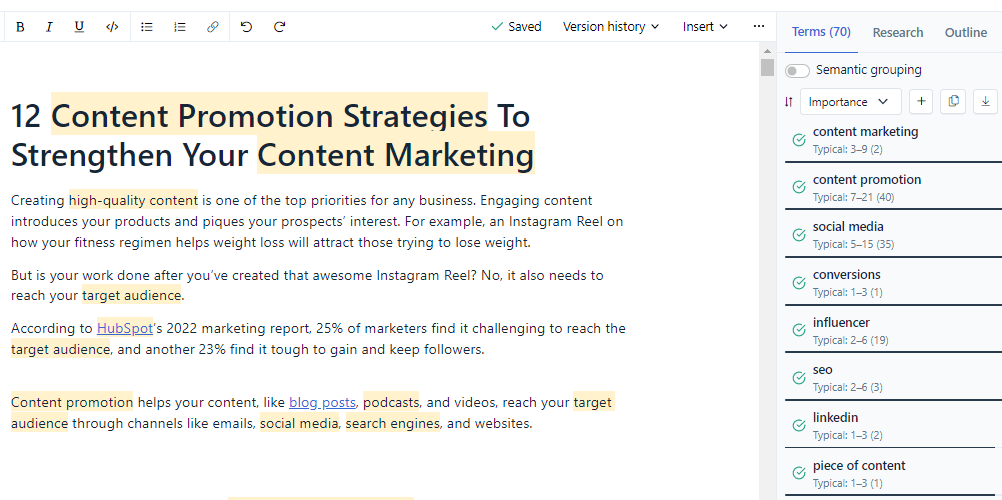
Screenshot
Clearscope gives you insight into what sections to include in your content to make it valuable for your audience. It also shows what terminology your competitors are using to construct a topic.

Screenshot
Repurpose your content for promotion
It’s easier to repurpose your content if you proactively plan your content promotion during the creation phase. Planning lets you create content with different formats in mind.
You can repurpose content into formats like:
Newsletters
Infographics
Videos and audio
Slideshows or carousels
Repurposing is a great way to promote through social media. For example, if you have a webinar, you can splice it up to create new pieces of content, like a series of YouTube Shorts or Instagram Reels.
According to Semrush, . So, why not try converting your articles into video content? You could use the audio from a webinar to create a podcast. You can also use tools like Lumen5 to create a video from article text.
You can also get creative with repurposing. Let’s say you’ve created a great long-form article with a quote from an influencer. You could ask the influencer to create a video elaborating on the quote.
Ross Simmonds, Founder and CEO of Foundation Marketing, is keen on repurposing content to increase its success.
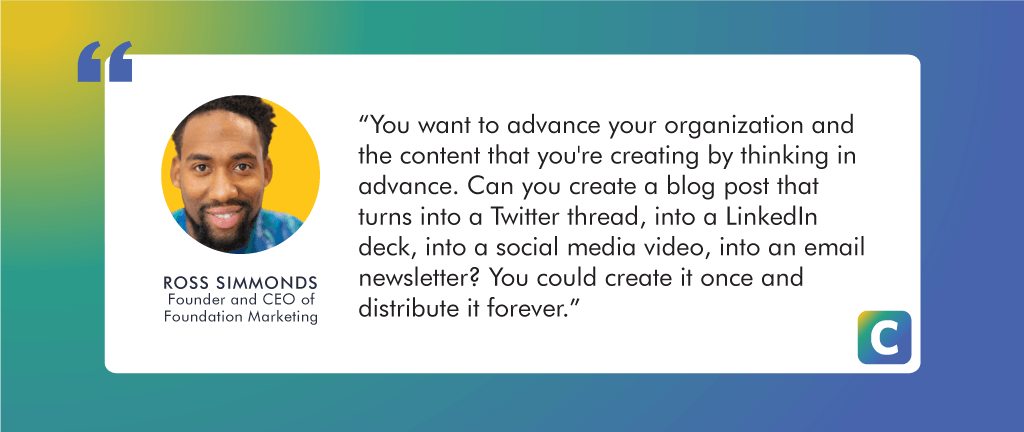
Ross Simmonds, Founder and CEO of Foundation Marketing, on content promotion.
Use social media to promote your content
Posting your content on social media is a great way to promote it to existing followers. However, these platforms are cluttered, so you need to be strategic about social media promotion.
Here are a few tips for promoting your content on social media.
Choose the right social media channel
First, you should find out which social media channel your target audience uses the most. Every social media channel has a different set of demographics. For example, most TikTok users are between the ages of 18-34.
If your product is more visual, like a clothing brand, Instagram might be the best platform. If you have a productivity tool for businesses, you might find your audience on LinkedIn.
Don’t just promote; engage
Posting on social media alone isn’t enough to boost the reach of your content. You should actively engage with your audience:
Reply to your audience’s comments quickly
Take part in conversations with your audience
Ask followers questions and seek their opinions
Use fun elements like memes or GIFs if you consider them on-brand
Use relevant hashtags — but don’t overuse them
You might be tempted to use multiple hashtags while posting on social media. But too many hashtags can make your content look like spam.
Use hashtags relevant to your niche and audience. Don’t use generic hashtags just because they’re popular. Keep in mind that Instagram recommends a maximum of 3-5 hashtags per post — and much fewer on other social networks like Twitter, LinkedIn, or Facebook.
Promote content through your email list
Not everyone who sees your promotional content on social media will be interested in it.
Email lists tend to be more tightly targeted as they contain people who have already shown interest in your products. If you don’t have an email list, it’s a good idea to start growing one.
Consider sending a weekly newsletter roundup of your content. Adding links to top-performing content in your marketing emails is also a good idea for content promotion.
You can also try an email newsletter swap with a complementary content partner. Your content partner could be another brand or content creator who sends a newsletter to your relevant audience. Feature your content in their newsletter in exchange for featuring their content in yours.
Collaborate with influencers
According to Influencer Marketing Hub, 83% of marketers believe influencer marketing is an effective marketing strategy, and its market size is forecasted at $21.1 billion for 2023.
Social media influencers include TikTok influencers, Instagram Reel creators, and YouTube personalities. But you don’t need to consider partnering with influencers on every social media channel — just those where your target audience is most likely to hang out.
Once you’ve identified the relevant platforms, seek out the influencers targeting your niche. For example, a TikTok video creator might influence a younger audience to buy a certain B2C product than an influencer on LinkedIn.
You’ll get the best results by including the influencer in your content creation process. Doing this will help create content that matches their style and aesthetics.
Use your collaborators’ micro-networks
You don’t necessarily need influencers with millions of followers to reach your ideal audience effectively. You can promote your content through micro-influencers and their micro-networks.
Let’s say you interview an expert in your niche while creating content. You could ask them to share that piece of content with their network.
They might have a smaller following, but they have a hyper-focused niche audience. This benefits your content promotion goals more than working with an influencer with a large but irrelevant audience.
If you quote an expert in your content, let them know with a follow-up email or message to encourage them to share your content. Share the content with those who have served as a resource for its creation.
For example, if you’ve included a link to another person's article, let them know and tag them in relevant social shares.
It’s important to note that while you should absolutely follow up with sources when your content publishes, don’t be too pushy about asking them to share it.
You may also want to collaborate with people inside your network, like your employees, vendors, and partners. Get in the habit of sharing content internally with your organization and encourage them to share it.
Make your content easy to share
Your audience shouldn’t have to work hard to share content. Include social media share icons in blog articles.
To increase the likelihood of sharing, use floating share buttons that stay on the screen while your readers scroll through an article. Sometimes a reader may want to share the article when they come across an interesting concept or quote.
You can use various tools to make quotes from your content shareable. Here are a few examples:
Sumo Image Sharer overlays social media icons on your images
Better Click To Tweet is a WordPress plugin that makes your content tweetable
Add a Pin It button to your images

Screenshot from Better Click To Tweet (image source).
Explore paid ads
While paid ads cost money, they’ll help your content reach a wider audience.
Try exploring paid content promotion options like:
Google Ads
Social media ads
Content networks
Influencer marketing
You should choose the paid ad channel based on your target audience. If most of your audience finds content through search engines, PPC ads make sense. On the other hand, if your audience spends more time on Instagram or Facebook, social media ads might be better.
Along with search engine ads, you can also explore advertising through content networks, such as Google Display Network. Content networks are a set of websites that display ads in return for revenue. You can create a Display Network ad through Google Ads.
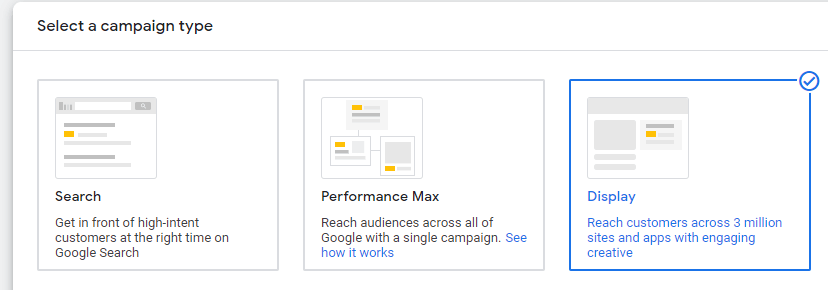
Screenshot of Google Ads.
Another option is to advertise on content websites relevant to your niche. For example, tech companies might advertise on Stack Overflow, while personal brands might lean towards Quora.
You can also use insights from your organic content promotion efforts for paid promotion. For example, let’s say you get the most engagement from people aged 50–60 — you should target that age group in your ads.
Whichever paid promotion channel you use, continually monitor your paid ad performance and adjust your audience targeting based on your observations.
Use content syndication & communities
Content syndication involves republishing your content on other websites. Syndication is great for reaching an audience outside your network. It's an efficient way of promotion, as it revolves around publishing the same content on various websites.
But note that you need to be cautious while using content syndication, as it might lead to a duplicate content issue. One way to avoid that issue is to use a canonical link pointing to the URL of the originally published work.
Actively participating in relevant content communities is also a great content promotion strategy.
Some examples of these communities include:
Subreddits
Quora
Relevant Facebook groups
Forums — like Hacker News or Stack Overflow for tech content
While interacting with content communities, you must add value to the community rather than just posting promotional content if you want to win over your target audience.
Answering questions is a great way to add value. And it’s an excellent way to nurture a niche audience and promote your content over time.
Use converged media
Converged media means combining two promotion channels, like paid + owned or earned + owned channels.
Brands are exploring how to combine promotion channels like paid, owned, and earned to reach a wider audience. Here are a few examples of converged media:
Earned + owned channels: Optimizing your content for search engines and earning a top rank or featured snippet on the SERPs.
Paid + owned channels takeover.
Paid + earned channels: Using a customer review as a Facebook ad.
You can use tools that improve your chances of content crossing channel barriers. For example, EmbedSocial can convert customer reviews to Facebook ads.
Monitor content promotion performance
You probably won’t achieve perfection with your content promotion strategy on the first go. When promoting content, select channels that you find the most relevant for your business.
You need to keep monitoring performance on these channels over time and define key performance indicators (KPIs), like:
Number of social shares
Number of click-throughs
Number of likes and comments
Monitor the values of the KPIs most relevant to your marketing goals and finetune your content promotion strategy based on those metrics.
Final thoughts: 12 content promotion strategies to boost content marketing
Content promotion is equally important to content creation. Using a wide range of content promotion strategies — including social media posts, email newsletters, and paid ads — is vital for getting the word out about your brand.
To be effective, understand what channels your target audience uses and focus on them. Start with a few content promotion strategies, observe performance, and then fine tune over time.
B2B Content Marketing Strategy: Steps to a Winning Strategy
Learn how to create a B2B content marketing strategy that doesn’t just increase brand awareness, but also drives leads, revenue, and customer loyalty.
Read moreHow to Create a Content Inventory & Perform a Content Audit
Our post explains how to perform a content inventory, audit your existing website content, and maintain an SEO-optimized site — in four simple steps.
Read moreTop 15 Content Marketing Benefits For Your Business
Discover the top 15 benefits of content marketing, including driving more organic traffic, generating leads, and building brand awareness.
Read more